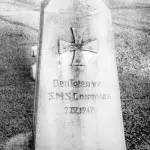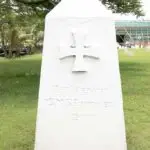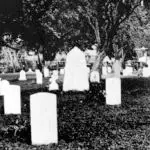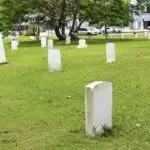SMS Cormoran II Memorial
Located in East Hagåtña on the beachside of Marine Corps Drive is a small cemetery maintained by the United States Navy. There are 254 listed graves in this space, nestled between a local car dealership on one side and Padre Palomo Beach Park on the other. The earliest grave marker is dated 1902, and the most recent 1955. US military personnel, CHamoru/Chamorro service members, and civilians—even children—are buried in this hallowed ground. Among the neatly laid rows of cambered or arc-shaped grave markers closest to the beach is a small white obelisk dedicated to the SMS Cormoran II and the seven crew members who died in the first skirmish between the US and Germany in World War I.
In December 1914, the SMS Cormoran II, an armed cruiser that was part of the German naval Pacific fleet (German East Asia Squadron), arrived in Guam’s Apra Harbor while trying to evade capture by the Japanese in the early months of World War I. Low on fuel, the captain and crew stopped in Guam but were not arrested. Instead, they were interned aboard their ship for over two years. During this time, they enjoyed relatively pleasant relations with US military personnel stationed in Guam as well as local Chamorros and frequently socialized with them. However, when the US formally entered the war in April 1917, the Cormoran was scuttled by its crew to keep it from falling into American hands. All but seven — two warrant officers and five enlisted men — of the 353-member crew survived. Six of the seven were buried with full military honors at the cemetery, while the body of the seventh sailor, Paul Burghart, was never recovered.
The men buried at the Naval cemetery are: Emil Reschke, Karl Bennershansen, Franz Blum, Hermann Glaser, Rudolph Penning and Ernest Roose. Their markers are simply carved with their names and the words “German Sailor” underneath. Although Glaser is anecdotally listed as buried here, his grave marker is not found among the graves of the Cormoran crew. A non-German crew member, K. Boomerum, a native from New Guinea, died later in 1918 and is also buried alongside the other Cormoran sailors.
The surviving German crew members, including their captain, Adalbert Zuckschwerdt, were taken as prisoners of war by the US Marines. The US Navy first held the officers at Camp Barnett, while the enlisted men were held at Asan. All but the Chinese and New Guinean crew members of the Cormoran were eventually sent to Fort Douglas, Utah, aboard the transport ship, USAT Thomas.
While they waited to be transported to the POW camp in the mainland, the Germans were given permission to erect next to the graves a meter-high cement obelisk. Capt. Zuckschwerdt, whom Governor Roy C. Smith had commended for his bravery, was allowed to speak at a ceremony in honor of the dead and the rest of the Cormoran crew.
Carved on the Cormoran monument is the inscription, “Den Toten von S.M.S. Cormoran, 7 IV 1917,” which means, “To the dead of the S.M.S. Cormoran, 7 April 1917.”
The scuttled Cormoran also became a monument. The navy salvaged the machinery and armament but left the rest of the ship at the bottom of Apra Harbor below 120 feet of water. In 1943 during the Japanese Occupation of Guam in World War II, the Japanese transport vessel Tokai Maru was sunk almost directly above the Cormoran and now rests alongside the German ship, making this the only site where two wrecks from two different World Wars can be found together on the ocean floor.
The Cormoran monument in Hagåtña was listed on the Guam Register of Historic Places on 14 July 1974 and the sunken vessel was listed on 24 July 1974. Then the Cormoran was listed on the National Register of Historic Places in 4 April 1975. In 1983, the National Park Service Resource Unit, along with the US Navy and War in the Pacific National Historical Park staff, conducted surveys of both the SMS Cormoran and Tokai Maru and were able to map out and illustrate the position of the two ships. In 2007 the 90th anniversary of the scuttling of the Cormoran was commemorated by wreath-laying ceremonies, an exhibit and a lecture series by the War in the Pacific National Historic Park. According to Guam historian Dr. Lawrence Cunningham who participated in the ceremony, a dive boat also laid coconuts to signify the Cormoran’s use of coconut husks as an alternative fuel source when they ran out of coal at Lamotrek atoll.
The US Naval Cemetery is now part of the Hagåtña Heritage Walking Trail and the Cormoran obelisk can easily be seen from Marine Drive. The sunken Cormoran is a fitting reminder of the intersection of Guam’s past with the larger events of world history. It is also a popular but challenging dive site in Apra Harbor, with over a 1000 divers a year visiting the wreck site through tours organized by local dive companies.
For further reading
Brown, Joanne Salas. “Hagåtña Heritage Walking Trail.” In Guampedia, last modified 29 September 2020.
Cunningham, Lawrence. Personal interview. Hagåtña, Guam. 22 April 2015.
Scuba Diving. “Guam to Commemorate the 90th Anniversary of the SMS Cormoran.” 7 March 2007.




